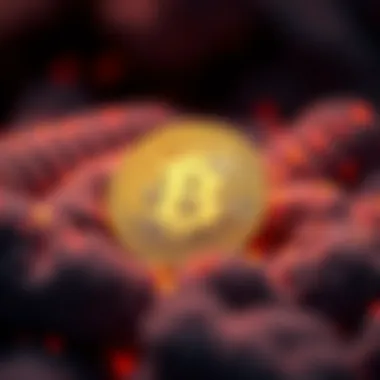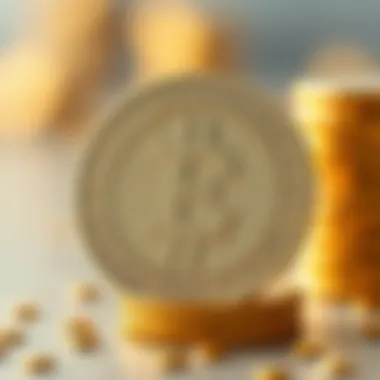Creating an ERC20 Token: A Detailed Guide for All


Intro
Creating a new digital asset can feel daunting, especially with the rise of cryptocurrencies and the complex technology behind them. At the heart of many innovations in this space is the ERC20 token standard, which has become a cornerstone in building various applications on the Ethereum blockchain. For investors, developers, and educators alike, understanding how to create an ERC20 token isn't just an exercise in coding; it's about grasping the broader implications within the market and technology landscape.
In this guide, we'll dive deep into the essential steps needed to create an ERC20 token. We will also highlight crucial concepts in cryptocurrency, clarify technical jargon, and explore market trends. By the end, readers should not only know how to launch a token but also appreciate the intricacies and considerations involved—from smart contract fundamentals to navigating potential market impacts.
Key Concepts in Cryptocurrency
Understanding Blockchain Technology
Blockchain technology is essentially a ledger maintained across numerous computers, providing transparency and security. When it comes to ERC20 tokens, this underlying tech plays a vital role. Public access to the ledger allows for the decentralized nature of transactions, removing the necessity for intermediaries. Here's a brief breakdown of how it all fits together:
- Distributed Ledger: Each participant has a copy of the entire ledger, making it resistant to fraud.
- Immutability: Once data is recorded, it's nearly impossible to alter it, which boosts trust.
- Consensus Algorithms: These ensure that all transactions are agreed upon by network participants before being confirmed.
The Role of Smart Contracts
Smart contracts act like self-executing agreements coded directly onto the blockchain. They eliminate intermediaries by automating processes, which is particularly useful when developing an ERC20 token. Here are some crucial aspects:
- Automation: Transactions become faster since they execute automatically upon meeting agreed conditions.
- Cost Efficiency: Reduces costs by excluding middlemen from the transaction process.
- Security: Smart contracts operate exactly as programmed, reducing misunderstandings and disputes.
Laying this foundation equips us to explore the practicalities of developing and launching an ERC20 token effectively. Importantly, the design choices made within these smart contracts can have long-term ramifications both technically and economically.
Understanding ERC20 Tokens
To embark on the journey of creating an ERC20 token, it’s fundamental to grasp the concepts surrounding this specific token standard. ERC20 tokens have become vastly popular due to their versatile nature and ease of integration, making them a linchpin in the world of cryptocurrencies. Understanding these tokens is crucial for anyone involved in the crypto ecosystem, whether you’re a developer, investor, or just an enthusiastic learner.
Definition and Characteristics


ERC20 tokens are a category of digital assets that function on the Ethereum blockchain, adhering to a set of standard protocols. This standardization ensures that these tokens are interoperable and can be easily exchanged or incorporated into DApps, which are decentralized applications operating on the Ethereum network.
The defining features of ERC20 tokens include:
- Interoperability: Because they follow the same set of rules, ERC20 tokens can communicate with one another as well as with protocols or platforms that support the standard. This interoperability streamlines processes and expands use-cases.
- Transferability: They are designed for easy transferring between users. This property is crucial for trading, investing, and scaling.
- Fungibility: Each individual token is identical and can be exchanged on a one-to-one basis, much like traditional currency.
- Smart Contract Functionality: Each ERC20 token is linked to a smart contract that manages the token’s issuance, transfer, and ownership.
In simpler terms, think of ERC20 tokens as digital currencies that you can freely send, receive, or trade, all under a standardized umbrella. This provides both developers and users an ease of mind since the rules are clearly defined, leading to fewer complications during interactions.
Importance in the Crypto Ecosystem
The significance of ERC20 tokens within the crypto ecosystem cannot be overstated. They serve as the backbone for many Initial Coin Offerings (ICOs), allowing startups to raise funds while providing investors with a bite-sized piece of the blockchain pie. The following points highlight their indisputable role:
- Ecosystem Growth: Their standardization has stimulated the development of a multitude of applications and protocols, meaning new services continually emerge that leverage these tokens for unique purposes.
- Investor Accessibility: By allowing individuals to invest in tokens easily, ERC20 has democratized access to investment opportunities in blockchain technology. As a result, a plethora of projects have flourished, each hoping to innovate and capture market attention.
- Liquidity and Tradeability: Exchanges have developed around these tokens, enabling trade on numerous platforms ranging from centralized exchanges to decentralized ones. This liquidity enhances investor confidence and participation in the market.
In short, ERC20 tokens are not just a technical marvel but a catalyst for innovation and growth in the cryptocurrency landscape. Whether it’s a small team aiming to launch the next big idea or a comprehensive ecosystem that’s seeking diverse financial instruments, ERC20 tokens have laid the groundwork to make it all happen.
"Understanding ERC20 tokens is like having the key to the crypto kingdom. Without it, one might feel lost in the blockchain labyrinth."
For a deeper dive into ERC20 tokens, resources such as Wikipedia, Britannica, or community discussions on Reddit can offer valuable insights.
Prerequisites for Token Development
Before diving into the details of token creation, understanding the groundwork that sets the stage for successful development is crucial. This section delves into the essential prerequisites that any developer or enthusiast should grasp to ensure a smooth experience in creating an ERC20 token. The insights discussed here provide a foundation for comprehending not just the technical aspects but also the operational considerations essential for navigating the complex Ethereum landscape.
Understanding Blockchain Technology
At its core, blockchain technology is a decentralized ledger, designed to securely record transactions across a network of computers. Understanding this technology is paramount, as it underpins the entire process of creating and managing an ERC20 token.


- Decentralization: This aspect ensures that no single entity controls the network, promoting transparency and security. Without this understanding, one might overlook why blockchain offers advantages over traditional systems.
- Consensus Mechanisms: Grasping how transactions are verified—like Proof of Work or Proof of Stake—can help developers appreciate how their tokens will function in terms of transaction speed and security.
- Transactions and Blocks: Knowing how transactions form blocks and how they are added to the blockchain can inform developers about the efficiency of their tokens.
It's essential to embody this foundational knowledge to appreciate the intricacies involved in token development on the Ethereum blockchain. Engaging with resources such as Wikipedia's Blockchain page can provide a thorough introduction, while websites like Investopedia can break down complex terms further.
Familiarity with Smart Contracts
The next step in token development is a solid grasp of smart contracts. These self-executing contracts with the terms written into the code are fundamental to how ERC20 tokens operate.
- Definition: A smart contract is a program that automatically enforces and executes terms laid out in its code without the need for intermediaries. Understanding this can help eliminate reliance on third parties, streamlining operations.
- Programming Languages: Familiarity with languages like Solidity is essential since ERC20 tokens are mainly built using it. Knowing the basics—such as syntax and structure—helps in creating effective contracts.
- Security Considerations: Developers must be aware of potential vulnerabilities in smart contracts. For instance, flawed logic can lead to significant financial loss, as seen in many high-profile hacks. Understanding how to write secure code and identify common pitfalls is not just beneficial; it's mandatory.
- Testing and Auditing: Awareness of the importance of rigorous testing before deployment can save a developer from future headaches. Utilizing tools such as Truffle or Remix can streamline this process.
By wrapping one's mind around smart contracts, developers can significantly enhance both their expertise and the robustness of the tokens they create. Resources like Ethereum's official documentation and community forums on Reddit can also provide invaluable insights into best practices and coding tips.
Setting Up the Development Environment
Establishing a solid development environment is crucial when venturing into the creation of an ERC20 token. It acts as the backbone of your project, ensuring all necessary tools and software are in place for smooth execution. Just like a painter needs a well-organized studio filled with the right brushes and paints, developers require a tailored setup to bring their ideas to life on the Ethereum blockchain.
The importance of this section cannot be overstated. An efficient development environment not only streamlines the coding process but also minimizes potential errors, saving both time and resources in the long run. A lack of proper configuration can lead to unnecessary headaches, especially when debugging the smart contract code or deploying the token. Therefore, a thoughtful approach to setting up your workspace is essential for a successful token launch.
Required Tools and Software
Creating an ERC20 token involves various tools and software that enhance the entire development process. Here’s a breakdown of what you’ll need:
- Node.js: This JavaScript runtime environment is pivotal for executing JavaScript code server-side, allowing developers to run scripts directly from their computers.
- npm (Node Package Manager): A vital tool that helps manage dependencies and packages in your project. It simplifies the installation of libraries needed for token development.
- Truffle: A popular development framework for Ethereum. It provides a rich environment to compile, test, and deploy smart contracts, making your life easier as a developer.
- Ganache: This personal Ethereum blockchain is used for testing; it simulates a blockchain network on your local machine, which is crucial for testing before deploying onto the actual network.
- Remix IDE: A web-based integrated development environment that simplifies code writing, smart contract deployment, and debugging. It’s user-friendly, especially for beginners.
By stocking your toolkit with these essential components, you align yourself for a smoother development ride.
Installing Node.js and npm


Installing Node.js and npm is one of the first and foremost steps you’ll take in setting up your environment. This duo lays the groundwork for your project as both tools are foundational for managing the various JavaScript libraries that you’ll leverage in your token development.
Step-by-Step Installation Process:
- Download Node.js: Head over to the official Node.js website: nodejs.org. Here, choose the version that matches your operating system, whether it’s Windows, macOS, or Linux.
- Run the Installer: Once downloaded, run the installer. Follow the prompts, ensuring to select options that suit your system preferences.
- Verify Installation: Open your terminal or command prompt and type in the following commands:bash node -v npm -v
- Update npm: It’s wise to keep your npm updated. Use the command to upgrade to the latest version:
Completing these steps ensures you are equipped with the necessary environment to begin crafting your ERC20 token. Remember, a strong foundation leads to a successful project execution.
A well-prepared environment isn’t just about getting things done. It’s about getting them done faster and more efficiently, reducing the likelihood of complications down the line.
For further details on installation, consider visiting Wikipedia on Node.js or the official npm documentation.
Writing the Smart Contract
Writing the smart contract is a crucial aspect of creating an ERC20 token, serving as the backbone of its functionality. The smart contract performs the essential role of defining the rules and behaviors of the token. It’s akin to crafting a blueprint before embarking on constructing a building. Here’s why delving into smart contract writing is so pivotal:
- Functionality and Governance: The smart contract dictates how your token functions, including transferring tokens, approving spending, and tracking balances. Without it, your token wouldn’t be able to operate.
- Security: A well-written smart contract helps prevent exploits and vulnerabilities. Given that tokens are often targeted by malicious actors, emphasizing robust coding practices is paramount.
- Trust: Smart contracts run on the Ethereum blockchain, meaning they are transparent and immutable. Once deployed, you cannot change the rules, which fosters trust among users and investors.
- Efficiency: Automating various processes through smart contracts reduces the need for intermediaries, making transactions smoother and less costly.
Understanding these dimensions positions developers and investors alike to appreciate not only the technicalities involved but also the broader implications for trust and efficiency in the crypto space.
Key Components of the Contract
When drafting an ERC20 smart contract, several key components warrant attention:
- Token Name and Symbol: These are essential for user identification. The name reflects the project's identity, while the symbol is a shorthand representation, much like stock tickers in traditional finance.
- Decimals: This defines how divisible your token can be. Most tokens use 18 decimal places, akin to how Ether operates, allowing for precise transactions.
- Total Supply: This represents the maximum number of tokens that will ever exist. It’s important to clarify this early, as it will influence the token’s perceived value.
- Balance and Transfer Functions: Core to any token's functionality are the methods that manage user balances and facilitate token transfers between addresses. These functions ensure that transactions take place seamlessly.
- Approval and Allowance: These functions enable one user to authorize another account to spend a portion of their tokens, which is fundamental for features like exchanges and decentralized applications.
Here is a simplified example of how some of these components can look in code:
solidity contract MyToken is ERC20 string public name = "MyToken"; string public symbol = "MTK"; uint8 public decimals = 18; uint public totalSupply = 1000000 * (10 ** uint(decimals)); // Other functionalities to manage the token go here







